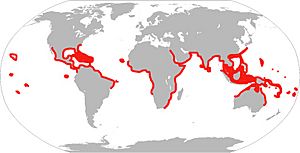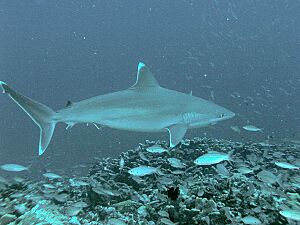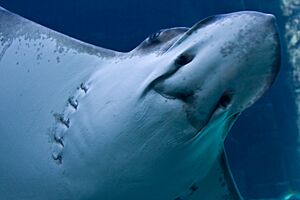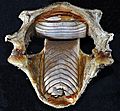Spotted eagle ray facts for kids
Quick facts for kids Spotted eagle ray |
|
|---|---|
 |
|
| Conservation status | |
| Scientific classification | |
| Kingdom: | |
| Phylum: | |
| Class: | |
| Order: | |
| Family: | |
| Genus: |
Aetobatus
|
| Species: |
A. narinari
|
 |
|
| Where the Spotted Eagle Ray lives (In Red) | |
The spotted eagle ray (Aetobatus narinari) is a type of fish with a skeleton made of cartilage, not bone. It belongs to the eagle ray family. You can find these amazing creatures in warm, tropical waters around the world. This includes places like Hawaii, the Gulf of Mexico, and parts of the Indian Ocean. They also live off the coast of west Africa and in Oceania.
Contents
What Does a Spotted Eagle Ray Look Like?
Spotted eagle rays are quite big! When they are born, they are about 17 to 35 centimeters (7 to 14 inches) wide. But adult rays can grow up to 5 meters (16 feet) long. Their "wingspan" (the distance from one wingtip to the other) can reach 3 meters (10 feet). An adult ray usually weighs between 180 and 225 kilograms (400 to 500 pounds). The heaviest one ever recorded weighed 230 kilograms (507 pounds).
These rays have flat, disk-shaped bodies. Their top side is dark blue or black and covered with many white spots. Their belly is white. They also have a flat snout that looks a bit like a duck's bill. Their tail is very long, much longer than most other rays' tails. Right behind their pelvic fins, they have 2 to 6 venomous spines.
How Do Spotted Eagle Rays Behave?
Spotted eagle rays like to swim in waters that are between 24 and 27 °C (75 to 81 °F). They are more active when the tide is high. These rays are generally shy animals and try to avoid people. However, there have been rare times when they have leaped out of the water onto boats.
They find their food by digging their snouts into the sand on the ocean floor. Spotted eagle rays often swim in groups of about six. All the rays in the group swim in the same direction and at the same speed. They enjoy eating crustaceans like shrimp, prawns, and crabs. They also eat molluscs such as octopuses, clams, and oysters.
Life Cycle and Reproduction
Spotted eagle rays are viviparous. This means they give birth to live young, instead of laying eggs. Female rays are pregnant for about one year. After this time, they give birth to around 2 to 4 baby rays. These babies are about 17 to 35 centimeters (7 to 14 inches) long when they are born.
Spotted eagle rays become adults when they are about 4 to 6 years old. They can live for around 15 to 20 years in the wild.
Who Are Their Predators?

The main predators of the spotted eagle ray are large sharks. These include the tiger shark, the lemon shark, the bull shark, the great hammerhead shark, and the silvertip shark. These sharks are known to follow female spotted eagle rays during the breeding season. They sometimes eat the newborn baby rays.
Where Do Spotted Eagle Rays Live?
Spotted eagle rays live in shallow, coastal waters and near coral reefs. They prefer tropical areas. You can find them in places like Hawaii, the Gulf of Mexico, Oceania, and west Africa. They also live in the Indian Ocean and off the west coast of the United States of America.
These rays can be found at depths of up to 80 meters (260 feet). In the Atlantic Ocean, they live from the coast of North Carolina down to Florida. They are also found in the Gulf Stream, throughout the Caribbean, and south past Brazil. In the Pacific Ocean, they live from the Red Sea to South Africa, and north to Japan and Australia.
Other Names for This Ray
The spotted eagle ray has a few other names. People sometimes call it the "White-spotted eagle ray." It is also known as the "bonnet skate," the "Bonnet ray," the "Duck-billed ray," and the "Spotted Duck-billed ray."
Images for kids
-
Three individuals off Belize. Spotted eagle rays are social and often occur in groups.
-
An eagle ray searching the bottom for food at Curaçao, Netherland Antilles
See also
 In Spanish: Raya jaspeada para niños
In Spanish: Raya jaspeada para niños









